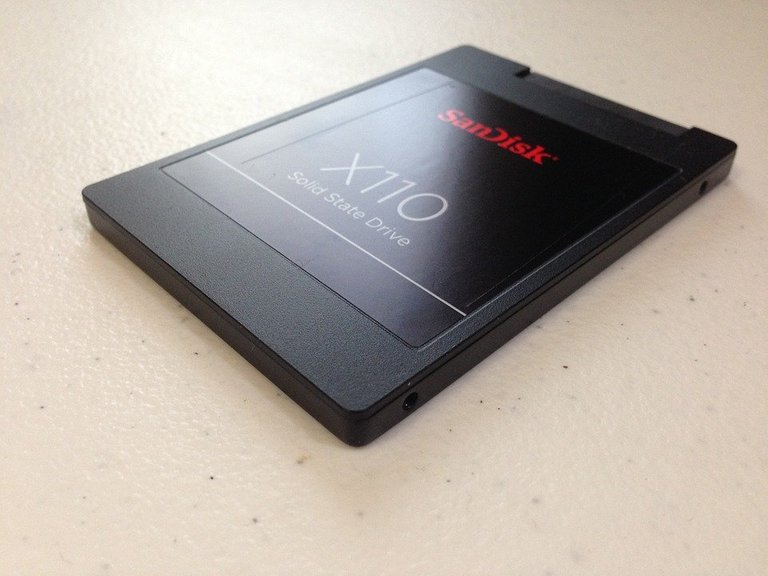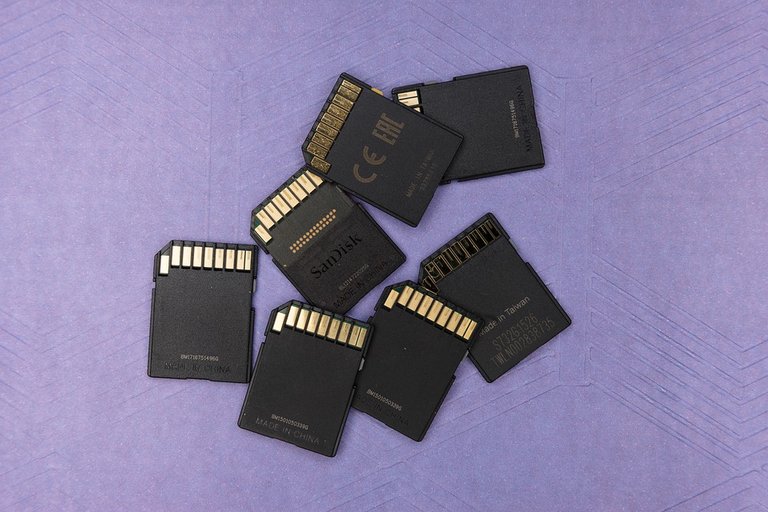
The first thing I want to ask you is why I do this post? Well because it is something that happens to most people who spend time on the internet both on the computer and cell phones or tablets, even video game consoles.
First hand in recent days I damaged a hard drive where I had most of my data had a capacity of 1 terabyte or 1000GB, this has happened to me several times, but not with that amount of information but varied, but still makes you feel bad that loss of data so today I come to give explanations of the durability of data storage products, where we keep our most important things or just what is ours to enjoy and the options we have to preserve our information, which at the end of all we value.
The Hard Disks
The hard disk that is normally used by most computers has a lifetime of between 5 to 7 years, although it depends on the time we use it since it is not the same to use it a few hours a day than to have it on for long periods.
But in this world we know that we can have electrical failures that can affect it, also affects the environmental factors, the location where the computer is, and its temperature.
It can degenerate over time damaging sectors and even if we have all that under control is inevitable to know when the clock needle will fail or when it can have a mechanical failure as happened to my hard drive that contained my data.

The SSD
They have been on the market for some time now and they are the alternative to hard disks and they are an improvement in many ways in this case the durability of the SSD would be 3,600 days, or what is the same as almost 10 years of useful life. Although it also depends on the use we give it for example if it is an office PC, Internet browsing and multimedia use or a Gaming PC varies greatly depending on whether you are installing and uninstalling games very often.
Also, the environment affects them, they can not be too cold or too hot, and also power failures can affect one or another time, but not as often as in the Hard Drives.

SD or microSD cards
They are the most expandable memory for cameras and cell phones, tablets, but SD memory of any kind should never be relied upon for long-term storage. The experience with SD memory is that the integrity begins to falter in as little as 5 years. The voltage stored in SD memory can dissipate the cells (of the components they are made of) and can be misinterpreted after a while. High temperatures accelerate the dissipation and shorten the storage of even less than 5 years.

USB Flash Drives
The external USB flash drives are more than the common element in our day-to-day life. They are our most important documents are safe, we can access them whenever we want and we can share them. They work on many occasions as an extra backup that saves us mountains of paper or paper photographs, but is it a copy that we will have for life?
There are many opinions on how long a USB lasts because its useful life is conditioned by the use it is given. In any case, and as a reference, the average that accredited voices talk about is 20 years of duration, during which you can write on them up to a million times. It is a highly reliable device some experts say that you are more likely to lose a USB flash drive if you lose it than because of a technical failure. Be that as it may, as with any other electronic device, the use is the main conditioner for its duration. Likewise, other factors such as the quality of the USB itself or the care given to it, also have a direct impact on its life cycle.
The quality of the USB: When we talk about how long a USB lasts, it is inevitable to allude to the manufacture of the device itself. The quality of the external memory is a key element when it comes to trusting that it will keep the information for the time we need and in a safe way. Opt for quality pen drives to avoid surprises and ensure proper operation.
Cleanliness: Try to keep your Pendrive safe from dust and dirt, especially when the USB connection head is not covered. If you opt for USB flash drives with a cover or swivel, this task will be easier, since the protection is already built-in. Dust is the enemy of the connection head and can cause malfunction.
Adverse conditions: Extreme humidity and heat are also risk factors to take into account when predicting how long a USB will last and working on extending its useful life. The classic recommendation is to keep it in a clean, cool, and dry place.

Cell Phones and Tablets
Most buyers barely wait two years to get rid of their "old" smartphone. It is easy to find an excuse to change their cell phone: it is outdated, it does not perform as well, it does not have 4G or 5G, the battery does not work well, the camera is broken... Or, simply, it went out of fashion. According to global data from the information site MarketWatch, the average consumer renews his cell phone every 15 months. And the average life of a cell phone today does not last much longer: between 18 and 24 months.

In conclusion, we must understand that all electronic devices have a life cycle, they can fail, they can be affected by the environment and if we value our information we must know how to protect it.
At the moment there are only two alternatives for backing up our information, one is to have the information on one of the devices that I mentioned before, which you can keep aside and take care of it, but of course, taking into account that over time it degenerates. Or there is the option of the cloud as those offered by Google with Drive, the one offered by Microsoft with OneDrive, also Amazon offers one called AWS, and we finish with several known as Dropbox, Mega, Mediafire.
Well, I hope this information has been of value to you, I hope you share it with people who may need to know this information and well let's try to avoid these accidents of loss of information as best we can.
Post en Versión Español

Lo primero que les quiero plantear es el ¿Por qué hago este post? Bueno debido a que es algo que le ocurre a la mayoría de personas que pasamos tiempo en internet tanto en la computadora como en celulares o tablets, hasta consolas de videojuego.
De primera mano en estos últimos días se me daño un disco duro donde tenía mayor parte de mis datos tenía una capacidad de 1 tera, ósea 1000gb, esto me ha pasado varias veces, pero no con esa cantidad de información sino variada, pero igual te hace sentir mal esa perdida de datos así que hoy vengo a darle explicaciones de durabilidad de los productos de almacenamientos de datos, donde guardamos nuestras cosas más importantes o simplemente lo que es nuestro para disfrutar y las opciones que tenemos para preservar nuestra información, que al final de todo la valoramos.
Los Discos Duros
El disco duros lo que usan normalmente la mayoría de computadoras tienen un tiempo de vida de entre 5 a 7 años, aunque depende del tiempo que lo usemos, ya que no es lo mismo utilizarlo unas pocas horas al día que tenerlo encendido durante largos periodos.
Pero en este mundo sabemos que podemos tener fallos eléctricos que le pueden afectar, también afecta los factores ambientales la ubicación donde esté el computador y la temperatura del mismo.
Puede irse degenerando con el tiempo dañándosele sectores y aunque tengamos todo eso controlado es inevitable saber cuando la aguja de reloj fallara o en sí cuando pueda tener una falla mecánica como le ocurrió a mi disco duro que contenía mis datos.

Los SSD
Ya llevan un tiempo en el mercado y son la alternativa a los discos duros y realmente son una mejora en mucho de los sentidos en este caso la durabilidad del SSD sería de 3.600 días, o lo que es lo mismo a casi 10 años de vida útil. Aunque también depende del uso que le demos por ejemplo si es un PC de ofimática, navegación por Internet y uso multimedia o un PC Gaming varía mucho dependiendo de si estás instalando y desinstalando juegos muy a menudo.
Igualmente el ambiente les afecta, no pueden estar ni muy fríos ni muy calientes y también los fallos eléctricos pueden afectarle uno que otro momento, pero no tan frecuente como en los Discos Duros.

Las tarjetas SD o microSD
Son la mayoría las memorias expandibles para las cámaras y celulares, tablets, pero nunca hay que confiar en la memoria SD de ningún tipo para el almacenamiento a largo plazo. La experiencia con las memorias SD es que la integridad comienza a tambalearse en tan solo 5 años. El voltaje almacenado en la memoria SD puede disipar las células(de los componentes que están fabricadas) y puede ser malinterpretado después de un tiempo. Las temperaturas altas aceleran la disipación y acortan el almacenamiento de incluso en menos de 5 años.

Los Pendrive o memorias USB
Las memorias externas USB son un elemento más que común en nuestro día a día. Son nuestros más importantes documentos están a salvo, podemos acceder a ellos siempre que queramos y los podemos compartir. Funcionan en muchas ocasiones como una copia de seguridad extra que nos ahorra montañas de papeles o fotografías en papel. ¿Pero es una copia que tendremos de por vida?
Hay muchas opiniones en cuánto dura un USB, básicamente porque su vida útil viene condicionada al uso que se le da. En todo caso, y como referencia, la media de la que hablan las voces acreditadas es de 20 años de duración, durante los cuales se puede escribir en ellos hasta un millón de veces. Se trata de un dispositivo de alta fiabilidad, de hecho dicen algunos expertos que hay más probabilidades de que te quedes sin una memoria USB por culpa de perderla que por motivos de un fallo técnico. Sea como sea, como cualquier otro dispositivo electrónico, el uso es el principal condicionante para su duración. Así mismo, otros factores como la propia calidad del USB o los cuidados que se le den, también tienen una incidencia directa sobre su ciclo de vida.
La calidad del USB: Cuando hablamos de cuánto dura un USB es inevitable aludir a la propia fabricación del dispositivo. La calidad de la memoria externa es un elemento clave a la hora de confiar en que nos guardará la información el tiempo que necesitamos y de una forma segura. Opta por pendrives de calidad para no llevarte sorpresas y asegurar su correcto funcionamiento.
La limpieza: Procura mantener tu pendrive a salvo del polvo la suciedad, sobre todo cuando la cabeza de conexión del USB no está cubierta. Si optas por los USB con tapa o giratorios, esta tarea será más sencilla, puesto que la protección ya viene incorporada. El polvo es enemigo del cabezal de conexión y puede provocar un incorrecto funcionamiento.
Condiciones adversas: Humedad y calor extremos son también un factor de riesgo a tener en cuenta a la hora de prever cuánto dura un USB y trabajar en alargar su vida útil. La recomendación es el clásico mantener en un sitio limpio, fresco y seco.

Celulares y Tablets
La mayoría de los compradores apenas espera dos años para deshacerse de su "viejo" smartphone. Es fácil encontrar una excusa para cambiar de teléfono móvil: quedó desactualizado, no rinde igual, no tiene 4G o 5G, la batería no funciona bien, se estropeó la cámara de fotos… O, simplemente, pasó de moda. Según datos globales del sitio de información MarketWatch, el consumidor promedio renueva su celular cada 15 meses. Y la vida media de un teléfono móvil en la actualidad no dura mucho más: entre 18 y 24 meses.

En conclusión hay que entender que todo aparato electrónico tiene un ciclo de viva, pueden presentar fallos, les puede afectar el ambiente y si valoramos nuestra información tenemos que saber como resguardarla.
Por los momentos solo existen dos alternativas para respaldar nuestra información uno es teniendo la información aparte en uno de los dispositivos que he mencionado con anterioridad que ese lo puedes tener apartado y cuidándolo, pero claro teniendo en cuenta que con el tiempo se degenera. O está la opción de la nube como las que ofrece Google con Drive, la que ofrece Microsoft con OneDrive, también Amazon ofrece una llamada AWS, y terminamos con varias conocidas como lo son Dropbox, Mega, Mediafire.
Bueno espero que esta información les haya sido de valor, espero la compartan con las personas que pueden necesitar saber esta información y bueno tratemos de evitar esos accidentes de perdida de información lo mejor que podamos.
Congratulations @elmisticooscuro! You have completed the following achievement on the Hive blockchain and have been rewarded with new badge(s) :
Your next payout target is 100 HP.
The unit is Hive Power equivalent because your rewards can be split into HP and HBD
You can view your badges on your board and compare yourself to others in the Ranking
If you no longer want to receive notifications, reply to this comment with the word
STOPSupport the HiveBuzz project. Vote for our proposal!